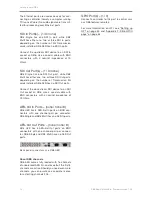
DB6: An introduction
8
DB6 Single / Multi / AES – Firmware version 1.30
DB6: An introduction
Thank you for choosing DB6 – the next step
in professional loudness control.
We want
to thank you for choosing this product, and we
hope it will serve you as a reliable, flexible loud-
ness processor for many years to come.
Consistency in loudness is the single most
important audio issue to get right in broad-
cast today.
DB6 employs cutting-edge tech-
nology allowing stations to avoid listener com-
plaints about jumping levels, while transmitting
both analog and digital signals with optimum
processing.
Keeping audio transparent
One of the finest things about new international
loudness standards is that a transparent signal
path is defined all the way from production to the
consumer. We therefore encourage you to take
advantage of DB6’s multiple ways of turning off
loudness processing for content that is already
normalized and suitable for a given platform.
Partial or full disabling of loudness processing
can be automatic or based on external signal-
ing. TC has taken initiatives to make such exter-
nal signaling part of open broadcast standards
– so expect new developments in this field. For
unknown content, rather than using DB6 to in-
flict “sausage processing”, use its built-in radar
meters to pull in loudness just enough. The goal
should not be to have all programs sit constantly
at Target level, but rather to have DB6 intervene
as a “safety belt” when something has gone
wrong upstream.
Production measurements such as
Program
Loudness
and
Loudness Range
will gradu-
ally make audio mixing more precise and down-
stream processing less needed. Therefore, re-
view your processing settings at regular inter-
vals, and be prepared to back them off as pro-
duction catches up.
DB6 and AC3 transmission
DB6 includes numerous functions to optimize
sound and logging when delivering to platforms
using the AC3 codec. While fixed AC3 metadata
recommendations in new ATSC and EBU guide-
lines means that there are fewer things that can
go wrong, the dynamics processor built into the
AC3 decoder (known as “DRC”) is still one of
the places where audio transparency tends to
get lost.
To prevent DRC from becoming the “sausage
processing” component of the signal path, we
recommended turning it off. DRC also isn’t
BS.1770 compliant, and the limited 20 dB head-
room in the “RF” path of AC3 can be dealt with
in better ways that are available in DB6.
Signal path transparency check
Once a transmission signal path has been con-
figured and adjusted, check that it is indeed
free of loudness processing when you think it
should be. A good indicator of this is Loudness
Range. Measure a program’s Loudness Range
in the production studio, and check if the value
stays the same when delivered to the consumer.
As long as no dynamics processing is applied,
Loudness Range does not change if a program
is offset in gain.
Loudness range is also robust even across lossy
data reduction unless a low bit rate (lower than
64 kbps) is used. For AC3 transmission, be sure
to check Loudness Range after a domestic de-
coder as the DRC system may unexpectedly be
engaged.
Solid foundations
TC’s involvement with high quality digital audio
dates back to the mid-eighties of the last cen-
tury. Our commitment to digital excellence has
continued over the years with equipment for the
music, film and mastering industries. The ad-
vanced loudness and true-peak meters in TC’s
signal processors are founded on ITU and EBU
standards – standards that TC has contributed
to significantly.
Many years of experience with analog and digi-
tal broadcast and the know-how of skilled engi-
neers: This is the foundation on which this prod-
uct was built. From the purist and quality-con-
scious hardware engineers to the software writ-
ers, some of whom were involved with designing
the MPEG codecs: The team who has worked on
this signal processor forms a competent, non-
dogmatic design group ready to take broadcast
audio to the next level.
We are confident you will value the result of their
hard work.
Содержание DB6
Страница 2: ......
Страница 4: ......
Страница 41: ...Updating DB6 firmware English Manual 2014 03 05 37...
Страница 73: ...Technical specifications English Manual 2014 03 05 69...
Страница 74: ...Technical specifications 70 DB6 Single Multi AES Firmware version 1 30...
Страница 75: ...Technical specifications English Manual 2014 03 05 71...
Страница 76: ...Technical specifications 72 DB6 Single Multi AES Firmware version 1 30 Item No E60537014...



























